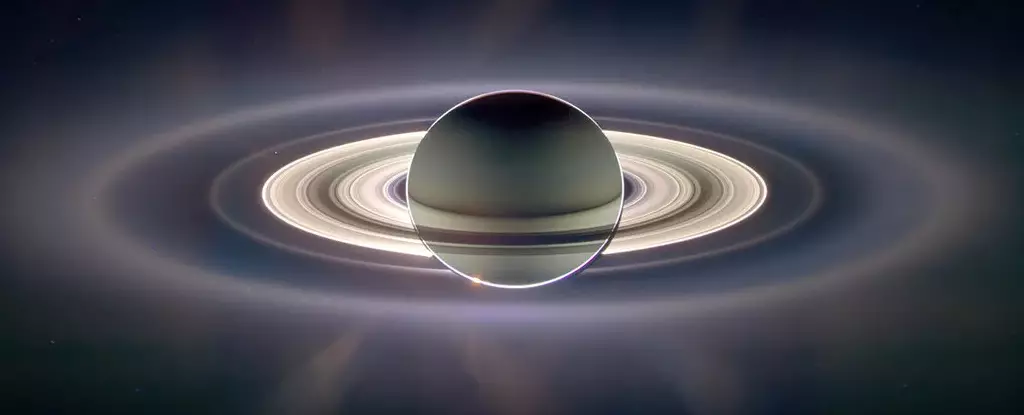Saturn, often referred to as the jewel of our Solar System, is immediately recognizable by its stunning rings. These magnificent structures have fascinated astronomers and the general public alike, serving as a central topic in discussions about planetary beauty in astronomy. Yet, as the Cassini spacecraft ventured into the Saturnian system in 2004, it unearthed an unexpected enigma: the ice particles and chunks that comprise the rings appeared remarkably pristine. This puzzling observation contradicted expectations, as scientists anticipated that eons of continuous micrometeoroid bombardment would have coated the ice with dust over billions of years. This revelation initially led researchers to speculate that Saturn’s rings were relatively young, possibly formed between 100 to 400 million years ago—an era contemporaneous with Earth’s dinosaurs.
However, a new study spearheaded by researchers from the Institute of Science Tokyo and the French National Centre for Scientific Research suggests that the story of Saturn’s rings is far more complex and ancient than previously thought.
Ryuki Hyodo, a planetary scientist involved in this groundbreaking study, explained that the pristine appearance of Saturn’s rings does not necessarily indicate youth. “Many accepted the notion of youth based merely on cleanliness, but our findings challenge that assumption,” Hyodo stated. This insight holds significant implications for future planetary exploration, underscoring the importance of questioning first impressions in scientific research. If Saturn’s rings are indeed ancient, their existence could reshape our understanding of planetary systems both within our Solar System and in exoplanetary studies.
In comparison, other giant planets like Jupiter, Uranus, and Neptune have rings that are far less conspicuous. Saturn’s rings are so prominent that they dominate the visual identity of the planet, raising questions about the frequency and lifespan of such structures across the cosmos. If Saturn’s rings could endure for billions of years, it follows that similar phenomena might also be common around gas giant exoplanets. This perspective invites new hypotheses that could elucidate the nature of ring systems, fundamentally transforming our comprehension of planetary evolution.
The initial assumption regarding the youth of Saturn’s rings was largely based on the apparent absence of dust, which scientists attributed to constant bombardments of high-speed micrometeoroids. To rethink this, Hyodo and his team conducted theoretical models to simulate the effects of these collisions. They discovered that when a micrometeoroid, about 100 microns in size, strikes an ice particle in the vacuum of space at speeds exceeding 25 kilometers per second, rather than smudging the ice, the collision vaporizes both the micrometeoroid and a minuscule patch of the ice surface. The aftermath of such impacts leads to the formation of nanoparticles.
These newly created nanoparticles and ions become charged within Saturn’s plasma environment, influenced by the planet’s magnetic field. Consequently, these particles are either pulled into Saturn’s atmosphere or ejected into space, leading to a fascinating conclusion: the icy rings maintain their brilliance because they are not significantly darkened by micrometeoroid impacts.
If this discovery is validated, it implies that Saturn’s rings could be billions of years old, thus extending our previous estimations of their longevity. The research lends itself to speculative considerations about the origins of these majestic rings and the dynamics of the early Solar System.
Beyond simply redefining the age of Saturn’s rings, this fresh interpretation could bear significant long-term implications regarding their future stability. The Cassini probe observed substantial amounts of material falling from the rings onto Saturn itself, which had been seen as evidence of a rapid decay process predicting an impending disappearance within just a few hundred million years. New findings, however, suggest that this “ring rain” may stem from the vaporization of micrometeoroid impacts instead.
With this new hypothesis in play, the narrative surrounding Saturn’s rings transforms dramatically. It suggests that these rings might not just have an ancient origin, but also a more enduring future. The early chaotic dynamics of the Solar System, filled with collisions between asteroids and planetesimals, might have played a crucial role in creating the debris that coalesced into the spectacular rings we witness today.
To further solidify these theories, Hyodo and his team are in the process of conducting laboratory experiments to replicate micrometeoroid impacts on ice particles. These physical simulations will aim to bridge theoretical insight with empirical evidence, enhancing our understanding of the processes at play around Saturn. The quest to unravel the mysteries of Saturn’s rings is far from over, and ongoing missions may illuminate facets of planetary systems that science has yet to unveil.
In essence, Saturn’s rings may not merely be a fleeting beauty, but a window into the ancient and dynamic processes that shape planetary systems across the universe. As research progresses, we are reminded of the remarkable complexities of cosmic phenomena that continue to challenge our perceptions and ignite our curiosity.


Leave a Reply